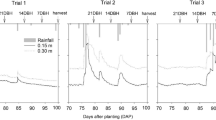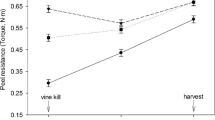Abstract
Potato (Solanum tuberosum L., ‘Russet Burbank’) vine desiccation was compared with sulfuric acid (89 kg ha−1 sulfur), dinoseb [2-(1-methylpropyl)-4, 6-dinitrophenol] (2.4 kg ha−1), diquat (6, 7-dihydrodipyrido [1,2-α:2′,1′-c] pyrazinediium ion) (0.28 kg ha−1) and endothal (7-oxabicyclo[2.2.1] heptane-2,3-dicarboxylic acid) (1.1 kg ha−1). All treatments were field-applied in southern Idaho during August and September. Vine (stem and leaf) desiccation was most rapid and consistent with sulfuric acid which averaged 42% desiccation at day one after treatment. Dinoseb and diquat at rates used were similar with desiccation of 19% and 17%, respectively, at day one. Endothal followed with 9% desiccation at day one. As diquat rates increased from 0.28 kg ha−1 to 0.55 kg ha−1, desiccation increased from 16% to 21% at day one. As diquat rate was further increased to 1.65 kg ha−1 vine desiccation was 25%. Major differences in desiccation rate occurred the first day. After the first day, rates of desiccation were mostly similar. Immature vines were desiccated more slowly than mature vines that were beginning to senesce. This difference between mature and immature vine desiccation was least with sulfuric acid. Several crop oils and surfactants evaluated with dinoseb and diquat were similar, except Mor-act that slightly increased dinoseb activity. Changes in tuber yield and quality were not associated with chemicals except as expected from desiccation.
Compendio
Se comparó el desecado de plantas de papa (Solanum tuberosum L., ‘Russet Burbank’) con ácido sulfúrico (0.89 kg ha−1 de azufre), dinoseb [2-(l-metilpropil)-4,6-dinitrofenol] (2.4 kg ha−1), diquat (6,7-dihidrodipirido [1,2-α:2′, 1′-c] pirazinediium ion) (0.28 k ha−1)y endotal (7 oxabiciclo 2.2.1 heptano-2,3-ácido dicarboxílico (1.1 kg ha−1). Todos los tratamientos se aplicaron en campo en el sur de Idaho durante Agosto y Setiembre. La desecación de la planta fué más rápida y consistente con ácido sulfúrico, con un promedio de desecación de 42% al día uno, después del tratamiento. El dinoseb y el diquat a las dosis usadas fueron similares, con desecación de 19% y 17% respectivamente, al día uno. El endotal fué el siguiente con 9% de desecación, al dia uno. A medida que se incrementaron las dosis de diquat de 0.28 kg ha−1 a 0.55 kg ha−1, la desecación aumentó de 16% a 21% al día uno. Cuando se incrementó aún más la dosis de diquat a 1.65 kg ha−1, la desecación de la planta fué de 25%. Las mayores diferencias en la velocidad de desecación ocurrieron el primer día. Después del primer día, las velocidades de desecación fueron generalmente similares. Las plantas inmaduras se desecaron más lentamente que las plantas maduras, las cuales empezaban ya a envejecer. Esta diferencia entre la desecación de plantas maduras e inmaduras fué menor con ácido sulfúrico. Diversos aceites agrícolas y surfactantes evaluados con dinoseb y diquat fueron similares con excepción del Mor-act, que aumentó ligeramente la actividad del dinoseb. Los cambios en rendimiento y calidad de los tubérculos no estuvieron asociados con los productos químicos, excepto como se esperaba de la desecación.
Similar content being viewed by others
Literature Cited
Findlen, H. and A.H. Glaves. 1964. Vine killing in relation to maturity of Red River Valley potatoes. USDA Technical Bulletin 1306.
Halderson, J.L., D.L. Corsini and L.C. Haderlie. 1985. Potato vine kill: stem-end discoloration effects on Russet Burbank. Am Potato J 62:273–279.
Halderson, J.L., L.C. Haderlie and D.L. Corsini. 1985. Potato vine kill: pulling, chemical killing and rolling effects on yield and quality of Russet Burbank. Am Potato J 62:281–288.
Hoyman, W.G. 1947. Observations on the use of potato vine killers in the Red River Valley of North Dakota. Am Potato J 24:110–116.
MacDowell, R.K. 1935. Potato blight. A new method of control by chemical spraying. Scottish J of Agric 18:243.
Murphy, H.J. 1968. Potato Vine Killing. Am Potato J 45:472–478.
Mutch, D.R., D. Penner, F. Roggenbuck and R.W. Chase. 1984. The use of additives, temperature and plant position to increase efficacy of dinoseb for potato (Solanum tuberosum) vine desiccation. Am Potato J 61:577–586.
Sanderson, J.B., J.A. Ivany and R.P. White. 1984. Effect of time of desiccation on seed potato yield and size distribution. Am Potato J 61:691–696.
Author information
Authors and Affiliations
Additional information
Approved for publication as paper No. 8773 by the Idaho Agricultural Experiment Station.
Rights and permissions
About this article
Cite this article
Haderlie, L.C., Halderson, J.L., Leino, P.W. et al. Chemical desiccation of potato vines. American Potato Journal 66, 53–62 (1989). https://doi.org/10.1007/BF02854424
Accepted:
Issue Date:
DOI: https://doi.org/10.1007/BF02854424




